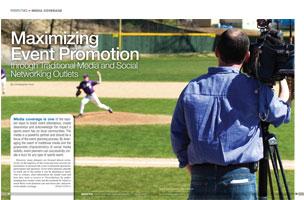
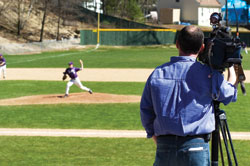 |
| Photo © Donald Linscott - Dreamstime.com |
Media coverage is one of the easiest ways to boost event attendance, create awareness and acknowledge the impact a sports event has on local communities. The media is a powerful partner and should be a focus of the event planning process.
By leveraging the reach of traditional media and the grassroots characteristics of social media outlets, event planners can successfully create a buzz for any type of sports event. However, many planners are focused almost exclusively on the logistics of the event and miss several opportunities to promote the event to potential spectators, participants and sponsors. Even when planners attempt to reach out to the media it can be daunting to know who to contact, what information the media want and how they want to receive it. Nevertheless, by understanding how media works and the methods by which to reach them, event planners can maximize pre- and post-event media coverage.
With the convergence of media and the rise of user-generated content event organizers are now able to effectively reach target markets with limited resources. A well constructed media relations strategy can elevate the status of smaller events and solidify the position of larger events - all to the benefit of the event planner, governing bodies, spectators and participants. The notion of putting together a solid media coverage strategy can leave planners feeling discouraged. Conversely with some very basic skills and knowledge an event planner can become media relations savvy in no time. Whether planners are seeking pre-event promotion or post-event coverage, there are essential methods that will lead to success.
The phrase 'media coverage' is a general term used interchangeably that can describe many activities tied to media including: media relations, marketing, advertising, trade sponsorship and social media. Because most sports events are run by small to mid-size associations or volunteer organizations, the main focus of the article is on cost effective media relations and social media outreach.
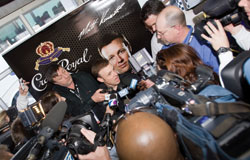 |
| Matt Kenseth gives interviews to the press during the Roush Fenway Racing 2010 Media Day at Charlotte Motor Speedway in Concord, NC. Photo © Walter Arce - Dreamstime.com |
Before a planner can execute the media relations tactics they must know who to contact. The easiest way to find the key media contacts is to call the major media outlets (TV, radio, print) in the city or region the event will take place. Ask who would cover stories related to a sports event and the best method for contacting them with story opportunities. Do not overlook the business or economic reporters and media outlets, especially if there is a chance to highlight the economic impact of the event (which is sometimes the best publicity).
Another method is to research the web sites of media outlets to mine e-mail addresses and contact information. Many outlets will provide general e-mail addresses for submitting news stories and ideas. Although web site mining is a sensitive means for collecting media contact information, it can be an extremely efficient method for event planners without vast resources.
For planners with a large media relations budget, many firms provide updated media contact information for specific markets at a fee.
A common notion is the more media contacts one can send information to the greater the chances the media will cover your event. In fact, a highly targeted media list will normally yield better coverage than a large list. Sending information to the appropriate media contacts with a realistic interest in the story will generate quality coverage for the event. Another belief is that having a prior relationship with media members is the only way to get coverage for the event. Not true. Placing appropriate information in front of the right media members at the right time is the key for successful media coverage.
Media Relations
For this article media relations can be defined as the proactive outreach by the event planner to media outlets via news releases and news conferences. These types of actions come with a relatively low cost to the planner and if executed correctly can be a great foundation for media coverage of an event. Media relations tactics are commonly used for milestone announcements related to an event such as the initial awarding of an event to a city, the signing of a multi-year contract or the economic impact of an event on the community.
News releases are written announcements, most commonly sent via e-mail to media outlets. The two biggest gaffes when writing a news release are not formatting it properly and not including newsworthy information in a form resembling a news story.
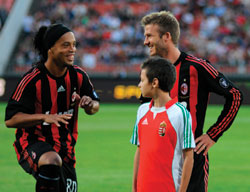 |
| Photo © Peter Muzslay - Dreamstime.com |
News releases should be crafted in a standard format (a Google search for 'news release example' listed 138 million results) and should include relevant information about your event. The who, what, when, where and why is a good place to start, but also include relevant facts, quotes from key officials, web sites and background information related to the event. When determining what to include, the planner must step back and ask himself, 'will the content be relevant to a media audience?' An over-the-top sales pitch will hurt the chances of the release being run by the media.
Additionally, a media contact and his or her information must accompany all releases. This person must be comfortable with answering questions from the media, appearing on television and radio and most importantly have knowledge of the event beyond what appears in the news release.
Planners should not limit themselves to one or two news releases prior to or after their event. Be creative and think of multiple angles that are newsworthy on their own. All events are unique and by sending multiple releases over a period of time a planner can create a level of rapport with the media. Lastly, always remember the less work media members have to do once they receive a news release, the more likely they are to publish it.
News conferences can be a powerful tool to interact with the media and allow them to develop in-depth stories related to an announcement about an event. A news conference should be saved for milestone announcements deemed exceptionally newsworthy.
How does one determine the 'newsworthiness' of the announcement? Put it through a smell test. Of course the event is important to the planner, but will it bring celebrities to town? It is the first time the event will be at a particular venue? Will it bring millions of dollars in economic impact to a community? Address these questions and others before inviting media to a venue for a news conference.
If the announcement is worthy of a news conference, decide on a quiet location where media can easily interact with important people related to the event or announcement. The event venue or an iconic backdrop offers media the chance to include associated video, sound or pictures with the announcement. Adequate lighting, power supplies and ease of access should be taken into consideration during a news conference venue selection.
Once a venue is selected, provide media with an advisory (search Google for examples) with the time, location, names of speakers at least two days prior. Make sure to include a short paragraph on what the news conference will cover without giving too much of the announcement away. Once the basics are covered, see if there are visuals available for the news conference. Examples could be soccer players kicking a ball around during the announcement of a major soccer tournament coming to a city or a team mascot accompanying event representatives or city officials.
Whether the planner decides on a news release or news conference, the overarching thing to remember is to make the media work as little as possible for a story. Events are normally a soft news story and are a pleasant change of pace for news media accustomed to covering hard news. Make time to follow up with media members, provide resources when possible and make key officials available on short notice. An event planner who makes it easy for media members will much likelier get to tell their story to the world.
Social Media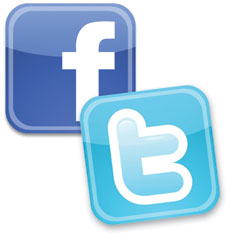 The hottest topic in media and marketing circles is the application of social media outlets within an overall media relations strategy. Arguably the two most popular social media channels are Facebook and Twitter. These free services offer event planners a vehicle to not only communicate important information, but to create an identity for the event in a less formal environment than traditional media. Each social media outlet differs in content, style and audience, but when implemented effectively they give planners a unique medium to generate allegiance to an event.
The hottest topic in media and marketing circles is the application of social media outlets within an overall media relations strategy. Arguably the two most popular social media channels are Facebook and Twitter. These free services offer event planners a vehicle to not only communicate important information, but to create an identity for the event in a less formal environment than traditional media. Each social media outlet differs in content, style and audience, but when implemented effectively they give planners a unique medium to generate allegiance to an event.
Facebook is a clearing house to post relevant links to web sites, video, news releases and updates on the day to day event details. A unique benefit to using Facebook is the ability to get feedback on information posted to the account. The two-way nature of communication can be used to generate loyal supporters who will show their loyalty to the event through wall postings and on their own profile page.
Interacting with 'fans' of an event is a great method to create word-of-mouth exposure for the event. Media members have been known to use information posted to Facebook for news stories, so make sure targeted media personalities are 'fans' of the event.
Twitter is a micro-blogging service which allows users to send and read messages known as tweets or brief updates on what's happening with an event. The service is fast becoming a tool for media relations professionals, politicians and business owners because of its ease of use, potential reach and simple functionality. Some of the world's largest corporations use Twitter to relay information about their services, products and events. But the service is not limited to large organizations.Twitter is a great medium for making announcements, posting links or tiny URLs and conducting contests to promote an event.
Although social media outlets are a cost-effective tool to generate excitement about an event, they are only as effective as the person who updates the accounts. Social media outlets are a direct result of the fast paced, instant gratification environment we live in today. Audiences of social media crave frequent and fluid exchanges of information. Constantly updating social media accounts with new and pertinent event information can create a loyal and growing following among users. Planners should instantaneously update social media accounts when they receive new information related to an event. Have a new vendor sign on to be a part of an event expo? Post it to the account. Finalize the bracket for a tournament? Upload the file immediately.
Is new merchandise available for purchase from the official event web site? Let people know with pictures of the swag. What once seemed to be mundane details are now the core components to a vibrant social media campaign. Whether the goal is to drive people to the event web site or to create awareness about the event, social media outlets can be great tools to incorporate into the event planning process.
Social media does not come without potential shortcomings. The double-edged sword of social media is the ability for 'fans' or 'followers' to interact with the event organizers. On the one hand, users can become third-party endorsers of the event by posting positive comments or experiences about past editions of the event. On the other hand, if a coach of a team not invited to a tournament decides to vent on the social media event page, it can become a sensitive situation for planners to deal with. As long as event officials and planners have a policy in place to deal with these types of circumstances, they can sidestep any possible land mines.
Media relations and social media outreach is an important part of any event planning process and with persistence can yield significant results for event planners. The two functions of media coverage discussed above provide an adequate base for event planners to begin to produce a simple, yet effective media coverage strategy. The combination of traditional media coverage and use of social media outlets can create excitement and awareness leading to increased participation, attendance and stature for the event. By following simple procedures and reducing the work media members have to do to get a story, an event planner can position their event favorably to a large audience.

